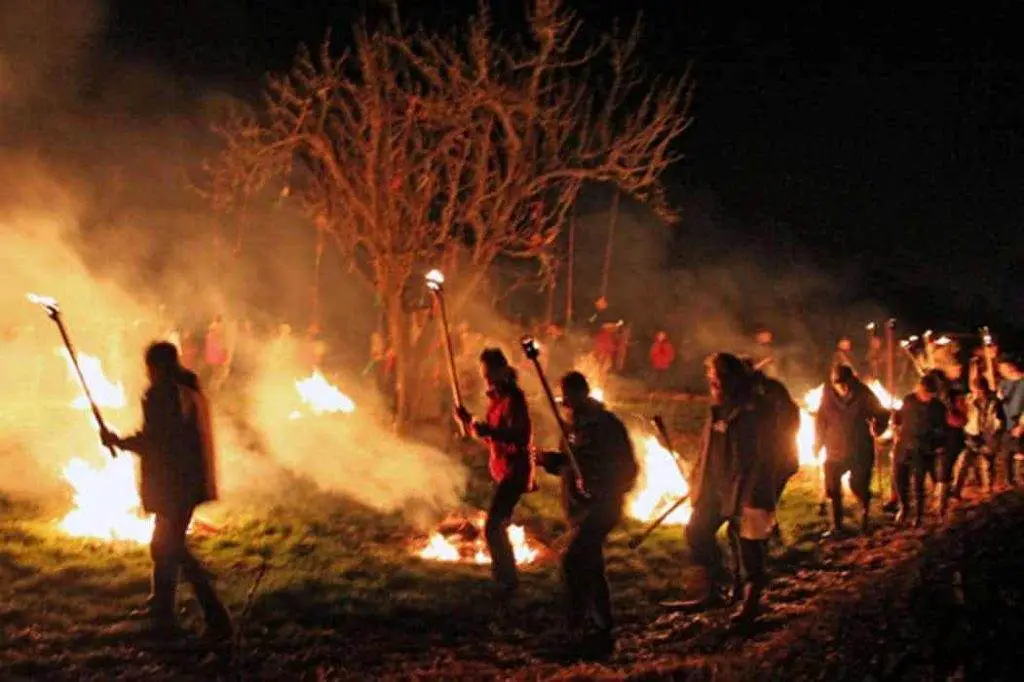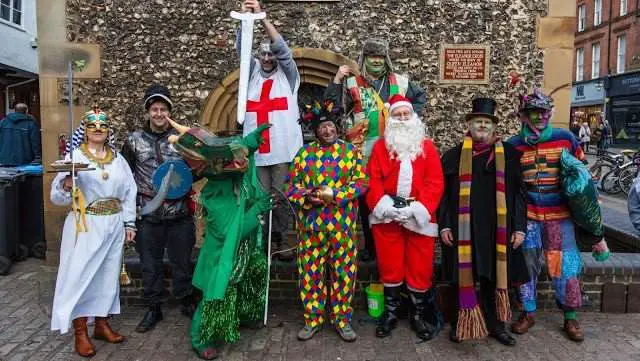Everyone knows about carolers and Christmas pantos, but very few people remember the ancient act of Wassailing, except as a lyric in an old Christmas carol.
The line “here we come a-wassailing” has been changed to “here we come a caroling” in most versions of the song. Most people don’t even remember the old tradition.
Wassailing and mumming were both holiday traditions that began with the Anglo-Saxons.
Wassailing
The word “Wassail” actually comes from an Anglo-Saxon word that means “be thou hale”, or “be in good health.”
It originated as a greeting, but by the twelfth century, the cry “was hail” and reply, “drink hail” became a toast. Though the toast became synonymous with Christmas,
Wassailing originally began as a general time of celebration. In places where Wassailing still takes place, it most happens on Twelfth Night, New Years, or Christmas.

What is Wassail?
Wassail was originally a drink made of mulled ale, curdled cream, roasted apples, eggs, clove, ginger, nutmeg, and sugar.
It may have been something like very strong eggnog. It was poured into a huge bowl. Some old wassail bowls could hold as much as ten gallons!
In the Anglo Saxon times, The Wassail was covered with a huge silver lid so that it would keep warm and was brought out for a carol and a toast before everyone in the community was allowed to take a drink.
Orchard Wassailing
Orchard Wassailing is slightly different from caroling wassailing.
It was common practice to visit the orchards as a community, during the holiday season.
As the trees are ready to hibernate for the winter, it’s customary to go into the orchard, to sing songs, dance, and light warming fires to scare spirits, and to celebrate the trees for their excellent crop, as well as “waking” them for next year.

The Anglo-Saxons believed that honoring the trees and protecting them from evil spirits could protect next year’s crops.
They also used to place toast soaked in beer or cider around the trees as an offering, and in thanks to the wonderful crop.
This is where the practice of “toasting” someone with an alcoholic drink comes from!
Orchard Wassailing was still practiced as late as the 1800s in Somerset, where a folktale describes the spirit of the oldest apple tree in the apple orchard.
The story goes, a Wassailing man offered his last mug of mulled cider to the trees. The Apple Tree Man appears and rewards him with buried gold.
As old as the practice of Wassailing is, you’ve probably heard of it. Even if it’s just from the holiday songs.
Mumming is an even older practice, and unlike Wassailing, many mumming groups still exist today.
English, Scottish, and Dutch settlers even took the practice to North America, cementing a tradition of mumming in Newfoundland, and other parts of Canada, and even in the US.
Mumming
Mumming is an ancient pagan custom, that goes back to at least the 11th century. It was first recorded as part of the festivities for the marriage of Edward I’s daughter.
It was basically just a chance to have a great neighborhood party.
Men and women would wear each other’s clothes or put on masks, or both, and perform plays, dances, sing songs, or other entertainments.
Mumming Around the UK

Different areas of the UK traditionally performed different types of entertainment, including special sword dances in Devon and Yorkshire, but includes some kind of comedy.
They may also include historical figures, like King George, or comedy versions of popular stories.
An interesting fact, King or Prince George is a common figure in the English countryside. Depending on the time of year, Father Christmas plays the role of the narrator.
But mumming isn’t just for Christmas. Some mumming groups can be seen around Bonfire Night, the night of the Winter Solstice, and New Years Night.
Mumming and Begging
It is customary to pass a hat after the mummer’s performance (Christmas is coming, the goose is getting fat… you know how it goes!)
But during his reign, the beggars became so prevalent among the mummers, Henry VIII passed a law that mummers were not permitted to wear masks.
So-called ‘respectable’ members of society found it a lot harder to take advantage of the hospitality.
In some parts of Canada, where the tradition was brought over by European settlers, it has been outlawed to curb the problem of begging.
Mumming and Wassailing may not be as popular they once were.
But these community activities have been around since the time of the pagans, and are part of a rich tradition. And still, remnants remain in today’s Christmas celebration.
There are even mummers groups across Europe, the UK, and North America, still active, and creating wonderful holiday memories.
Learn More With the Help of Video
Main Points About Wassailing and Mumming
- The Wassail is a drink made from apple cider, mulled ale, curdled cream, eggs, ginger, cloves, honey, nutmeg, ginger, and sugar. It is traditionally served in silver pewter.
- The wassailing is the custom of going house to house singing and offering wassail in exchange for gifts.
- Wassail comes from the Anglo-Saxon phrase ‘Waes hael’ which means ‘good health’.
- Humming is a custom of going house to house with costumes or masks, singing dancing and sometimes putting on a play.
- Wassailing and humming go way back to the medieval and Roman times. Today, the practice is gradually being displaced by caroling.
Conclusion
Wassail was originally a drink, similar to very strong eggnog. Drinking this together turned into a way of greeting each other merry Christmas.
Mumming is another ancient pagan tradition in the UK and the meaning of the word mumming is “making a diversion in disguise”.
The tradition was that men and women would swap clothes and in masks go visiting the neighbors, singing, dancing and playing theatre. The leader would be dressed as Father Christmas.
Word Cloud for Wassailing and Mumming
The following is a collection of the most used terms in this article on Wassailing and Mumming. This should help in recalling related terms as used in this article at a later stage for you.

- https://prezi.com/-25c3galkdet/the-history-of-wassailing-and-mumming/
- http://www.bellsandmotley.com/wassailpage.html
- https://en.wikipedia.org/wiki/Wassailing
Last Updated : 06 February, 2024

Chara Yadav holds MBA in Finance. Her goal is to simplify finance-related topics. She has worked in finance for about 25 years. She has held multiple finance and banking classes for business schools and communities. Read more at her bio page.


The historical significance of Wassailing and mumming serves as an essential reminder of the cultural diversity and evolution of traditions. It’s imperative that we delve into these narratives.
Absolutely, knowledge of these historical practices enriches our awareness of cultural heritage and fosters a deeper connection to our traditions.
The article provides an engaging account of the historical origins of Wassailing and mumming. Understanding the historical context of these traditions is truly enlightening.
Indeed, delving into the ancient customs of Wassailing and mumming offers a captivating insight into the evolution of holiday traditions.
I had never heard of Wassailing and mumming before. It’s amazing to think about how different holiday traditions have evolved over time and how they tie back to ancient practices.
Indeed, it’s a testament to the enduring nature of human traditions. It’s illuminating to learn about these rich cultural practices.
Absolutely, it’s incredible how traditions have transformed throughout history. The evolution of these customs is very intriguing.
What an interesting article! The tradition of Wassailing is fascinating and traces back to the Anglo-Saxons. It’s a tradition that is unfortunately fading. It’s nice to know about these ancient customs.
Absolutely, it’s a part of our cultural heritage that’s worth preserving and learning more about.
Yes, I agree. It’s sad that many of these old traditions are disappearing, but articles like these help keep the memory alive.
This article provides a valuable exploration of ancient traditions that are overlooked. It’s crucial to recognize and understand the legacy of these customs in contemporary society.
This article presents a thought-provoking examination of ancient customs that have contributed to contemporary holiday celebrations. It’s important to acknowledge the roots of these practices.
Indeed, understanding the historical underpinnings of holiday traditions enhances our appreciation for the depth and diversity of cultural heritage.
Absolutely, it’s a testament to the enduring legacy of ancient customs and the significance of preserving the knowledge of these traditions.
Learning about ancient customs like Wassailing and mumming is an intellectually stimulating experience. It’s an integral part of understanding our cultural heritage.
Absolutely, exploring the historical roots of these traditions broadens our comprehension of cultural heritage and customs.
The historical context of Wassailing and mumming provides valuable insights into the evolution of holiday traditions. It’s essential to recognize these cultural influences.
Indeed, articles such as these facilitate a deeper appreciation for the diverse cultural origins of contemporary customs.
Absolutely, the depth of historical understanding enriches our holiday experiences and strengthens our cultural awareness.
It’s enlightening to gain insight into the historical contexts of Wassailing and mumming. Learning about these traditional practices adds a deeper layer to our understanding of the past.
Yes, it allows us to appreciate the rich tapestry of our cultural history and understand the origins of various customs.
It’s a form of cultural education that sheds light on the diverse traditions that have contributed to shaping our contemporary society.
From this article, we can see how old traditions have shaped our modern customs. It’s unfortunate that many of these traditions are fading away, but it’s crucial that we keep the knowledge of them alive.
Absolutely, the cultural roots and historical significance should be acknowledged and preserved.